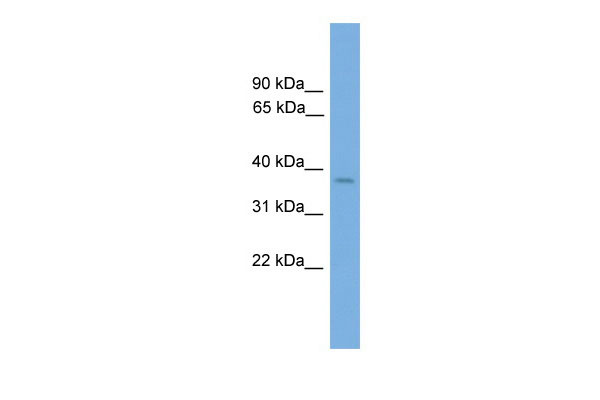Six3 antibody - C-terminal region
Rabbit Polyclonal Antibody
- SPECIFICATION
- CITATIONS
- PROTOCOLS
- BACKGROUND

Application
| WB |
|---|---|
| Primary Accession | Q62233 |
| Other Accession | NM_011381, NP_035511 |
| Reactivity | Human, Mouse, Rat, Zebrafish, Bovine |
| Predicted | Mouse, Zebrafish |
| Host | Rabbit |
| Clonality | Polyclonal |
| Calculated MW | 35kDa |
| Gene ID | 20473 |
|---|---|
| Alias Symbol | Six3a, Six3alpha, Six3b, Six3beta, E130112M24Rik |
| Other Names | Homeobox protein SIX3, Sine oculis homeobox homolog 3, Six3 |
| Format | Liquid. Purified antibody supplied in 1x PBS buffer with 0.09% (w/v) sodium azide and 2% sucrose. |
| Reconstitution & Storage | Add 50 ul of distilled water. Final anti-Six3 antibody concentration is 1 mg/ml in PBS buffer with 2% sucrose. For longer periods of storage, store at 20°C. Avoid repeat freeze-thaw cycles. |
| Precautions | Six3 antibody - C-terminal region is for research use only and not for use in diagnostic or therapeutic procedures. |
| Name | Six3 |
|---|---|
| Function | Transcriptional regulator which can act as both a transcriptional repressor and activator by binding a ATTA homeodomain core recognition sequence on these target genes. During forebrain development represses WNT1 expression allowing zona limitans intrathalamica formation and thereby ensuring proper anterio-posterior patterning of the diencephalon and formation of the rostral diencephalon (PubMed:18094027). Acts as a direct upstream activator of SHH expression in the rostral diencephalon ventral midline and that in turn SHH maintains its expression (PubMed:18775421). In addition, Six3 activity is required for the formation of the telencephalon. During postnatal stages of brain development is necessary for ependymal cell maturation by promoting the maturation of radial glia into ependymal cells through regulation of neuroblast proliferation and migration (PubMed:22071110). Acts on the proliferation and differentiation of neural progenitor cells through activating transcription of CCND1 AND CCND2 (PubMed:17576749). During early lens formation plays a role in lens induction and specification by activating directly PAX6 in the presumptive lens ectoderm (PubMed:17066077). In turn PAX6 activates SIX3 resulting in activation of PDGFRA and CCND1 promoting cell proliferation (PubMed:12072567). Also is required for the neuroretina development by directly suppressing WNT8B expression in the anterior neural plate territory (PubMed:20890044). Its action during retina development and lens morphogenesis is TLE5 and TLE4-dependent manner. Furthermore, during eye development regulates several genes expression. Before and during early lens development represses the CRYGF promoter by binding a SIX repressor element (PubMed:11139622). Directly activates RHO transcription, or cooperates with CRX or NRL (PubMed:17666527). Six3 functions also in the formation of the proximodistal axis of the optic cup (PubMed:12163408), and promotes the formation of optic vesicles-like structures (PubMed:11458394). During pituitary development, acts in parallel or alternatively with HESX1 to control cell proliferation through Wnt/beta-catenin pathway (PubMed:18694563). Plays a role in eye development by suppressing WNT1 expression and in dorsal-ventral patterning by repressing BMP signaling pathway (By similarity). |
| Cellular Location | Nucleus {ECO:0000255|PROSITE-ProRule:PRU00108, ECO:0000269|PubMed:12050133} |
| Tissue Location | Expressed in ependymal cells during the formation of the lateral wall. |

Thousands of laboratories across the world have published research that depended on the performance of antibodies from Abcepta to advance their research. Check out links to articles that cite our products in major peer-reviewed journals, organized by research category.
info@abcepta.com, and receive a free "I Love Antibodies" mug.
Provided below are standard protocols that you may find useful for product applications.
If you have used an Abcepta product and would like to share how it has performed, please click on the "Submit Review" button and provide the requested information. Our staff will examine and post your review and contact you if needed.
If you have any additional inquiries please email technical services at tech@abcepta.com.













 Foundational characteristics of cancer include proliferation, angiogenesis, migration, evasion of apoptosis, and cellular immortality. Find key markers for these cellular processes and antibodies to detect them.
Foundational characteristics of cancer include proliferation, angiogenesis, migration, evasion of apoptosis, and cellular immortality. Find key markers for these cellular processes and antibodies to detect them. The SUMOplot™ Analysis Program predicts and scores sumoylation sites in your protein. SUMOylation is a post-translational modification involved in various cellular processes, such as nuclear-cytosolic transport, transcriptional regulation, apoptosis, protein stability, response to stress, and progression through the cell cycle.
The SUMOplot™ Analysis Program predicts and scores sumoylation sites in your protein. SUMOylation is a post-translational modification involved in various cellular processes, such as nuclear-cytosolic transport, transcriptional regulation, apoptosis, protein stability, response to stress, and progression through the cell cycle. The Autophagy Receptor Motif Plotter predicts and scores autophagy receptor binding sites in your protein. Identifying proteins connected to this pathway is critical to understanding the role of autophagy in physiological as well as pathological processes such as development, differentiation, neurodegenerative diseases, stress, infection, and cancer.
The Autophagy Receptor Motif Plotter predicts and scores autophagy receptor binding sites in your protein. Identifying proteins connected to this pathway is critical to understanding the role of autophagy in physiological as well as pathological processes such as development, differentiation, neurodegenerative diseases, stress, infection, and cancer.


